Sachertorte
|
Sachertorte from the Hotel Sacher, Vienna | |
| Type | Cake |
|---|---|
| Place of origin | Austria |
| Region or state | Vienna |
| Creator | Franz Sacher |
| Main ingredients | Chocolate sponge cake, apricot jam, dark chocolate icing |
|
| |



Sachertorte (German pronunciation: [ˈzaxɐˌtɔʁtə]) is a specific type of chocolate cake, or torte, invented by Austrian Franz Sacher[1] in 1832 for Prince Wenzel von Metternich in Vienna, Austria.[2] It is one of the most famous Viennese culinary specialties.[3] 5 December is National Sachertorte Day.[4]
History
Origins
Recipes similar to that of the Sachertorte appeared as early as the 18th century,[1] one instance being in the 1718 cookbook of Conrad Hagger, another individual represented in Gartler-Hickmann's 1749 Tried and True Viennese Cookbook (Wienerisches bewährtes Kochbuch).
In 1832, Prince Wenzel von Metternich charged his personal chef with creating a special dessert for several important guests.[1] The head chef, having taken ill, let the task fall to his sixteen-year-old apprentice, Franz Sacher,[2] then in his second year of training in Metternich's kitchen. The Prince is reported to have declared, "Let there be no shame on me tonight!" While the torte created by Sacher on this occasion is said to have delighted Metternich's guests, the dessert received no immediate further attention. Sacher completed his training as a chef and afterward spent time in Bratislava (Pressburg) and Budapest, ultimately settling in his hometown of Vienna, where he opened a specialty delicatessen and wine shop.
Sacher's eldest son Eduard carried on his father's culinary legacy, completing his own training in Vienna with the Royal and Imperial Pastry Chef at the Demel bakery and chocolatier, during which time he perfected his father's recipe and developed the torte into its current form. The cake was first served at the Demel and later at the Hotel Sacher, established by Eduard in 1876. Since then, the cake remains among the most famous of Vienna's culinary specialties.
Legal issues
In the early decades of the twentieth century, a legal battle over the use of the label "The Original Sacher Torte" developed between the Hotel Sacher and the Demel bakery. Eduard Sacher completed his recipe for Sacher Torte while working at Demel, which was the first establishment to offer the "Original Sachertorte " cake. Following the death of Eduard's widow Anna in 1930 and the bankruptcy of the Hotel Sacher in 1934, Eduard Sacher's son (also named Eduard Sacher) found employment at Demel and brought to the bakery the sole distribution right for an Eduard-Sacher-Torte.
The first differences of opinion arose in 1938, when the new owners of the Hotel Sacher began to sell Sacher Tortes from vendor carts under the trademarked name "The Original Sacher Torte". After interruptions brought about by the Second World War and the ensuing Allied occupation, the hotel owners sued Demel in 1954, with the hotel asserting its trademark rights and the bakery claiming it had bought the rights to the name "Original Sacher Torte".
Over the next seven years, both parties waged an intense legal war over several of the dessert's specific characteristics, including the change of the name, the second layer of jam in the middle of the cake, and the substitution of margarine for butter in the baking of the cake. The author Friedrich Torberg, who was a frequent guest at both establishments, served as a witness during this process and testified that, during the lifetime of Anna Sacher, the cake was never covered with marmalade or cut through the middle. In 1963 both parties agreed on an out of court settlement that gave the Hotel Sacher the rights to the phrase "The Original Sachertorte" and gave the Demel the rights to decorate its tortes with a triangular seal that reads Eduard-Sacher-Torte.
Composition
The cake consists of a dense chocolate cake with a thin layer of apricot jam on top, coated in dark chocolate icing on the top and sides. It is traditionally served with unsweetened whipped cream.[5] [6]
Variations
The "Original" Sacher Torte has two layers of apricot jam between the outer layer of chocolate icing and the sponge base, while Demel's "Eduard-Sacher-Torte" has only one. Additionally, the Sacher Torte has a more coarse grain of sponge whereas the Demel Torte sponge is denser and smoother.
There are various recipes for cakes similar to the "Original", and some may be found below. For example, at "Graz-Kulturhauptstadt 2003", a festival marking the city of Graz being declared cultural capital that year, "Sacher-Masoch-Torte" was presented (its name alluding to Leopold von Sacher-Masoch), using redcurrant jam and marzipan.
Production and sale of the "Original Sacher Torte"
Hotel Sacher's "Original Sacher Torte" is sold at the Vienna and Salzburg locations of the Hotel Sacher, at Cafe Sacher branches in Innsbruck and Graz, at the Sacher Shop in Bolzano, in the Duty Free area of Vienna airport and via the Hotel Sacher's online shop.
The recipe of the Hotel Sacher's version of the cake is a closely guarded secret. Those privy to it claim that the secret to the Sacher Torte's desirability lies not in the ingredients of the cake itself, but rather those of the chocolate icing . According to widely available information, the icing consists of three special types of chocolate, which are produced exclusively by different manufacturers for this sole purpose. The hotel obtains these products from Lübeck in Germany and from Belgium.
The original Sacher Torte
Vienna claims to be the "coffee house capital of the world".[7] A strong tradition of coffee houses created an environment where both residents and visitors could meet, share ideas, and leisurely discuss the events of the day. The coffee house status in Vienna would become central to its culture and tradition with the cornerstone of each fine coffee house being its freshly-baked cakes. These classic tortes were to become highly regarded works of art and intense rivalries developed as to who could create the finest masterpiece. Today, the Original Sacher Torte is one of the most recognized cakes in the world and even helped establish the five star Hotel Sacher in Vienna founded in 1876 by Franz Sacher's son, Eduard Sacher. The Original Sacher Torte is still made almost entirely by hand using Franz Sacher's recipe and is a closely guarded secret. More than 360,000 cakes a year are made in Vienna by its 41 employees, many of which are shipped all over the world allowing a "taste of Vienna" to be delivered to many far away places. The most popular destinations for its cakes are Germany, Italy, France, The US, and many countries in Asia.
The Original Sacher Torte is a combination of two layers of soft and light chocolate cake separated by apricot jam and coated with a chocolate icing, often accompanied with unsweetened whipped cream. The tradition of Grand Hotels having their own signature cake continued with the creation of the "Imperial Torte" to celebrate the opening of the Hotel Imperial during the 1873 World's Fair in Vienna. The cake was designed to impress the Emperor Francis Joseph I and the square shaped chocolate torte is still produced today. Other Vienesse classic cakes include a Sacher Torte made by Demel confectionery which up until the early 1960s had fought a legal battle over the name rights of the cake. The "Esterházy torte" can trace its legacy back to the days of the ruling Hungarian family of the same name and is still produced in many of Vienna's coffee houses.
The issue of the "torte wars" and the competition to create a memorable cake is significant considering how coffee houses and their cakes have become an integral part of Viennese culture. Bookstore/coffee houses often provide the same type of environment, a place to relax, meet friends or family, and talk about important issues in peoples lives. A number of new franchises being established shows a trend in America has embraced part of this export of Viennese culture.
See also
| Wikibooks Cookbook has a recipe/module on |
References
- 1 2 3 It all started with a cake
- 1 2 Bell, Bethany (31 May 2007). "Happy Birthday, cake". BBC News. Retrieved 2007-05-31.
It was created by chance one day in 1832 when the chef to the chancellor, Prince Wensel Metternich, suddenly fell ill. His 16-year-old apprentice, Franz Sacher, was called in to create a dessert that would not disgrace the prince and the Sachertorte was born.
- ↑ Wiennese cuisine Sachertorte
- ↑ Karl Louderback. "National Days". Louderblog. Retrieved 15 December 2011.
- ↑ Original Sachertorte
- ↑ Original Sachertorte (German)
- ↑ Wienna
External links
| Wikimedia Commons has media related to Sachertorte. |
- The Original Sacher Torte website
- Sachertorte recipe by Delia Smith
- The only Sacher-Shop outside Austria
- Original Sacher Torte recipe (en)
- Original Sacher Torte (de)
- Sachertorte - BBC Food Recipes

